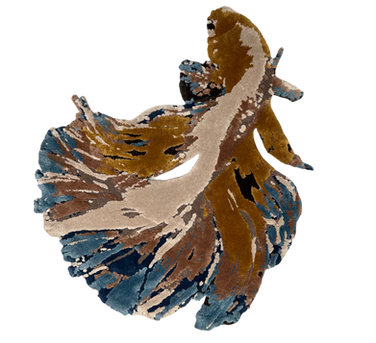Sanat Eserleri
Dokuma Resim: Fırat Neziroğlu’nun Yorumuyla
Dokuma resimler, geleneksel olarak dikey tezgâhlarda dokunur. Bu teknikte çözgü ve atkı iplikleri birbirini dik açıyla keser. Çözgü iplikleri tezgâhta dikey olarak gergin tutulur, atkı ipliği ise bunların arasından yatay olarak geçirilir. Ancak sıradan dokumalardan farklı olarak, dokuma resimlerde çözgü iplikleri tamamen görünmez; yüzeyde sadece atkı iplikleri yer alır. Genellikle kısa tutulan renkli atkılar, yalnızca kendi küçük alanlarında çalışılır. Böylece, farklı renklerin bir araya gelmesiyle desenler oluşur ve yüzey düz, atkı ağırlıklı bir yapıya kavuşur.
Fırat Neziroğlu’nun geliştirdiği ve patenti kendisine ait olan teknik sayesinde, dokuma yüzeyinde boşluklar bırakılabilir. Onun yarattığı özel düğüm kombinasyonları, dokuma sanatında bugüne dek görülmediği kadar gerçekçi görsel etkiler yaratır. Üstelik, klasik ipliklerin ötesine geçerek misina gibi çağdaş malzemeleri dokumaya dahil etmesi, bu sanata yepyeni bir soluk getirir.
Fırat bir esere başlarken bilgisayar programları ya da kareleme sistemleri kullanmaz. Ona göre bu tür planlamalar dokumayı fazla durağanlaştırır. Bunun yerine, tasarımlarını hissederek, doğaçlayarak, her an değişebilecek özgür kombinasyonlarla oluşturur. Onun için dokuma yaşayan bir şeye dönüşür.
Tüm üretim süreci boyunca tek başına çalışır. Bu durumu şöyle açıklar: “Bir piyanisti dinlemeye gittiğinizde piyanonun tuşlarına asistanı basmaz."
Bugün Fırat’ın tekniği dünyada birçok üniversitede öğretiliyor. “Fırat Neziroğlu gibi Dokumak” başlıklı atölye çalışmaları farklı ülkelerde düzenleniyor. Yaşamı ve sanatı; Amerika, Kanada ve Mısır’da birer, Türkiye’de ise üç yüksek lisans tezine konu oldu. Kendi tekniği artık resmen akademik literatürde.
Ayrıca ismiyle birlikte Üniversite Sınavı olan TYT'de ve ALES sınavında soru olarak yer aldı.


























